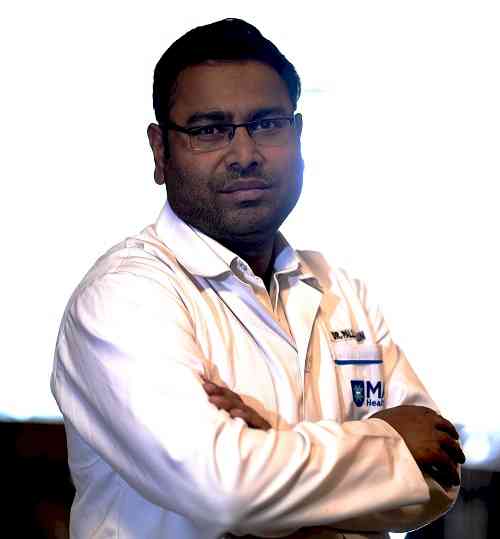All you need to know about Childhood Pancreatic Cancer
Cancer is an abnormal and uncontrollable division of cells and when it occurs in the cells of the pancreas, it is called pancreatic cancer. About six inches long, the pancreas is a glandular organ located in the abdomen. It secretes pancreatic juices that contain enzymes that aid in digestion and produce several hormones, including insulin. People of any age can develop pancreatic cancer and it usually begins in the cells of the pancreatic tissues.

by Dr. Karan Sehgal, Surgical Oncologist, HCG EKO Cancer Centre Kolkata
Cancer is an abnormal and uncontrollable division of cells and when it occurs in the cells of the pancreas, it is called pancreatic cancer. About six inches long, the pancreas is a glandular organ located in the abdomen. It secretes pancreatic juices that contain enzymes that aid in digestion and produce several hormones, including insulin. People of any age can develop pancreatic cancer and it usually begins in the cells of the pancreatic tissues.
Childhood pancreatic cancer, a rare but aggressive form of cancer, is a disease in which cancer or malignant cells form in the tissues of the pancreas. Pancreatic cancer among children could be of 4 types - solid pseudopapillary tumor of the pancreas, pancreatoblastoma, islet cell tumors and pancreatic carcinoma. These affect children and young adults aged six months to 15 years. Pancreatic cancer is often detected late, spreads rapidly and has a poor prognosis. Thus, knowing the signs and symptoms to detect it early, being aware of the various kinds of childhood pancreatic cancer and the risk factors and treatment methods are essential to tackle childhood pancreatic cancer.
Signs of childhood pancreatic cancer to watch out
The early symptoms of pancreatic cancer are
● A feeling of tiredness and fatigue
● Weight loss without any reason
● Loss of appetite
● Discomfort in stomach
● Lump in the abdomen
Interestingly, some pancreatic tumours among children do not secrete hormones and no signs and symptoms get exposed. Therefore it becomes hard to diagnose cancer at an early age.
Different kinds of childhood pancreatic cancer
1. Solid pseudopapillary tumour of the pancreas: The most common kind of pancreatic cancer affecting children, especially females that are older adolescents and young adults, is slow growing and has both cyst-like and solid parts. While these tumours have a lesser possibility of spreading to other parts of the body, they may occasionally spread to the liver, lung or lymph nodes.
2. Pancreatoblastoma: This affects children aged 10 years or younger, especially those with Beckwith-Wiedemann syndrome, a genetic, overgrowth syndrome when the infants are larger and taller than normal and familial adenomatous polyposis (FAP), a rare, inherited condition caused by a defect in the adenomatous polyposis coli (APC) gene. These are slow-growing tumours and may spread to the liver, lung and lymph nodes.
3. Islet cell tumours: These are not very common tumours among children and may be benign or malignant. This kind of tumour occurs among children with multiple endocrine neoplasia type 1 syndromes. The most common islet cell tumours are insulinomas and gastrinomas.
4. Pancreatic carcinoma: This is very rare in children. Two types of pancreatic carcinoma are acinar cell carcinoma and ductal adenocarcinoma.
Identifying the causes of childhood pancreatic cancer
Most childhood cancerous tumours in the pancreas are due to a combination of genetic and environmental factors. Not just that, certain genetic conditions like Hippel Lindau syndrome and multiple endocrine neoplasia (MEN) syndromes also amp up the risk of childhood pancreatic cancer.
Diagnosing and treating childhood pancreatic cancer
Childhood pancreatic cancer can be diagnosed through several tests like
1. Physical exam and health history: This is an exam of the body to check the general signs of the disease like that of a lump or anything that’s unusual. A history of the child’s health habits and past history is also recorded.
2. Chest X-Ray: An X-Ray of the chest gives a clear picture of the inside organs and bones inside the chest.
3. CT Scan: This produces a series of photos of the areas inside the body, such as the chest and abdomen taken from different angles. Sometimes, a dye is injected through the vein or swallowed to project the tissues and the organs more clearly.
4. MRI: Magnetic Resonance Imaging (MRI) uses a magnet, radio waves and computer to make a series of detailed images of the chest, abdomen, etc.
5. PET scan: Positron Emission Tomography scan helps in finding malignant tumour cells in the body. This is done by injecting a small amount of radioactive glucose into a vein. Malignant cells show up prominently in the picture taken by the PET scanner as they are more active and take up more glucose compared to normal cells.
Other diagnostic procedures include Endoscopic ultrasound (EUS), Somatostatin receptor scintigraphy and Biopsy.
Three kinds of treatment are available for children with pancreatic cancer are surgery, chemotherapy and targeted therapy. These treatment approaches may cause various side effects among children like physical problems, mood swings, change in feeling, learning, thinking and memory.
While preventing childhood pancreatic cancer is difficult, maintaining a healthy body weight among children considerably lowers the risk. The parents must ensure that their children are eating right, not obese and are leading an active life. If one notices any unusual symptoms, consult a doctor immediately.


 City Air News
City Air News 





